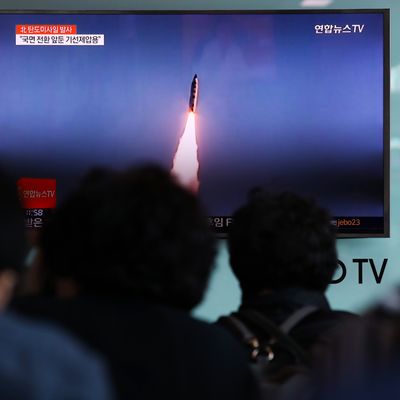
North Korea is known for its over-the-top threats — like a recent video depicting the destruction of the U.S. Capitol — but there could be some truth to its claims about the missile it launched on Sunday morning. The ballistic missile traveled from Kusong, in western North Korea, over the country, and landed about 60 miles off the coast of Russia.
On Monday North Korean state media identified the missile as the Hwasong-12, a “new ground-to-ground medium long-range strategic ballistic rocket” that’s capable of “carrying a large-size, heavy nuclear warhead.” The report included a threat from North Korean leader Kim Jong-un to the U.S.: Any provocation will be met with “the biggest disaster in history,” because the U.S. “mainland and Pacific operation region are in the D.P.R.K.’s sighting range for strike.”
North Korea’s missiles can’t reach the U.S. mainland just yet, but Sunday’s test may have shown that it’s making progress toward that goal, and can already hit U.S. bases in the Pacific.
North Korea said the missile was purposely fired at a high angle to avoid hitting a neighboring country. In a blog post, David Wright, a director of the Global Security Program at the Union of Concerned Scientists, said that if the missile were fired on a standard trajectory, it would have a range of about 4,500 kilometers (2,800 miles) — which puts the U.S. territory of Guam in striking distance.
This range is considerably longer than the estimated range of the Musudan missile, which showed a range of about 3,000 km in a test last year. Guam is 3,400 km from North Korea. Reaching the U.S. West Coast would require a missile with a range of more than 8,000 km. Hawaii is roughly 7,000 km from North Korea.
The U.S. military’s Pacific Command said the weapon fired was “not consistent with an intercontinental ballistic missile,” but according to missile expert John Schilling, the test “represents a level of performance never before seen from a North Korean missile.” Schilling wrote on the website 38 North that it may mean the nation is getting closer to developing an intercontinental ballistic missile:
If North Korea has already conducted a successful test using the engines and other components of the first two stages of the KN-08, it may be closer to an operational ICBM than had been previously estimated. US cities will not be at risk tomorrow, or any time this year. since some tests have to be done with the full-scale system. With only one test of this reduced-scale system Pyongyang is probably some time from even beginning that process.
Tensions between North Korea and the Trump administration were running high in recent weeks, though President Trump recently said that under the right circumstances” he would be “honored” to meet with Kim Jong-un. Sunday on ABC’s This Week, U.S. Ambassador to the United Nations Nikki Haley said the administration will “continue to tighten the screws” on the North Korean leader. She also stated the obvious: “Having a missile test is not the way to sit down with the president, because he’s absolutely not going to do it.”
North Korea’s intended audience might have been Russia and China, not the U.S. Beijing is currently hosting a trade and infrastructure summit with various world leaders, including Russian President Vladimir Putin. Carl Schuster, a Hawaii Pacific University professor and former director of operations at the U.S. Pacific Command’s Joint Intelligence Center, told CNN that the launch tells China, North Korea’s closest ally, “I don’t care what you think, I’m independent.” The missile landing so close to Russia says, “I can touch you, too.”
Schuster speculates that North Korea may be trying to get Russia to intervene against the increased sanctions being pushed by the U.S. “It’s his way of telling the Russians, ‘You need to speak up,’” he said.






























